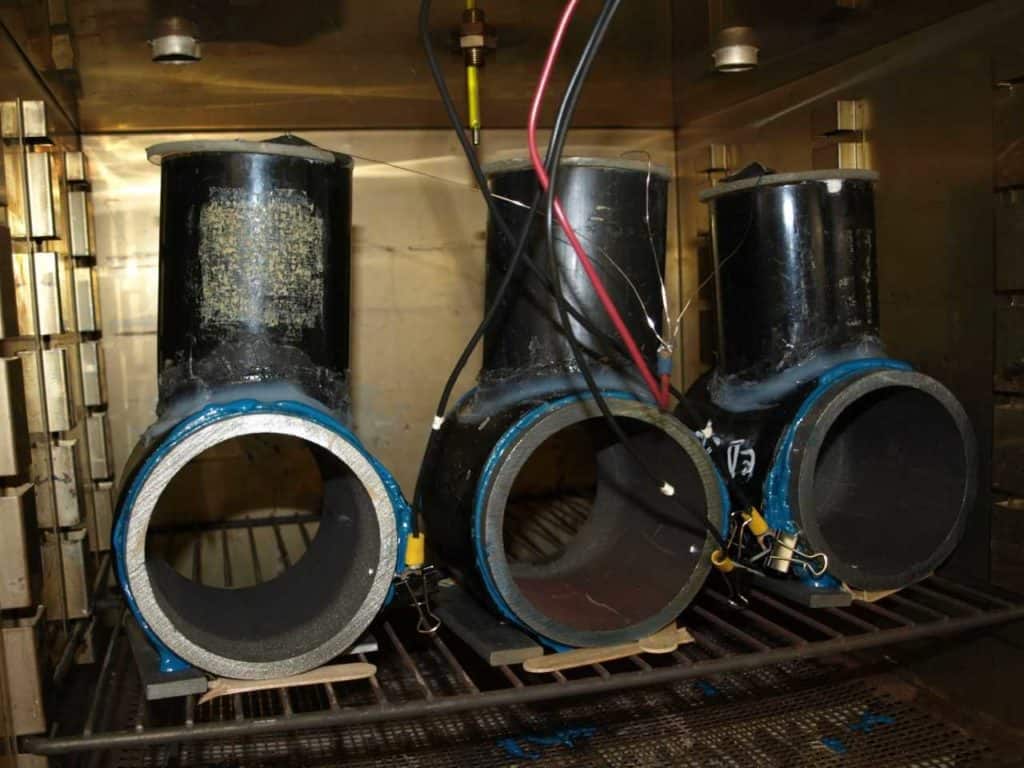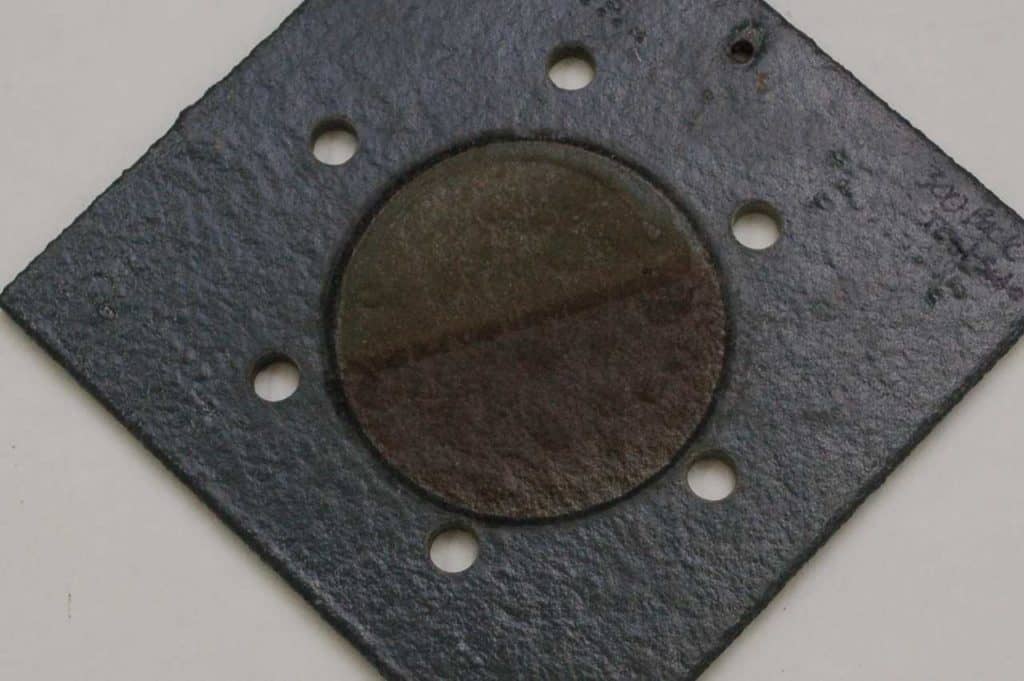High temperature-resistant coatings are used in a variety of industries and markets to prevent corrosion of steel subjected to extreme temperatures while in service. There are several testing protocols that are used to evaluate the performance of these coatings; however, performance comparisons are challenging since there is little uniformity or consistency of the test methods. This article lists the industries and markets that employ heat-resistant coatings, describes the generic types of products available, along with the various testing protocols, and presents the consequences of non-uniform comparisons of performance prior to installation.
I’ll begin by defining “High-temperature Service,” which is considered an exposure environment where coatings are used on steel with surface temperatures typically ranging from 120°C (250°F) to over 760°C (1,400°F). High-temperature-resistant coatings are designed to withstand these conditions while providing corrosion protection.
High-temperature coatings are frequently used in the aerospace, manufacturing, military, petrochemical and power industries for piping, fireproofing, jet engines, offshore rigs, original equipment and various type of plants/facilities that employ high-temperature processes.
One of the largest users of industrial high-temperature coatings is processing facilities such as power plants, petrochemical plants, and refineries. These facilities often have an extensive network of piping, vessels, and tanks that need protection from corrosion. Since high temperature steel is often insulated, corrosion under insulation (or CUI) is frequently a concern, as active corrosion cannot be seen with the unaided eye unless the insulation is first removed.
The requirements of high-temperature service coatings in process-based facilities vary depending on whether they are for new construction, maintenance, or hot-surface (in-situ) applications; each is described in more detail below.
The primary requirements of a heat-resistant coating in new construction include performance over a wide temperature operating range, minimal application time, and transportation from the fabrication shop to the jobsite with minimal handling damage. The traditional use of a single coat of inorganic zinc (IOZ), or an inorganic zinc top coated with a thin film application of a high-heat silicone, or an epoxy (heat resistance typically is a maximum of 350°F) covers many new construction installations. But, restrictions for use are often placed for under-insulation applications. NACE SP01-98 recommends that under insulation IOZ systems should only be used at temperatures above 120°C (248°F), and should not be topcoated. For service under insulation, single-component silicone coatings are often used for a wide range of operating temperatures to protect against CUI.
Maintenance applications of high-temperature liquid coatings is challenging. Often areas requiring maintenance have limited access or are situated in multi-use areas. Therefore, abrasive blast cleaning is often not possible, and hand or power tool cleaning is the only possible method of surface preparation. However, many of the traditional coating systems for high temperature service require a minimum SSPC-SP 10 “Near-white Blast Cleaning” surface cleanliness; therefore, material selection is very limited.
Equipment/process outages for maintenance painting can be costly, so there is obvious interest in coating while the equipment remains in service. Epoxy phenolic coatings are often used for these applications; however, there are a considerable number of other generic types that can be applied to hot surfaces with an application surface temperature threshold well above the operating temperature of the equipment.
High Temperature Coating Types and Characteristics
Composed of either organic or inorganic materials, high-temperature coating types are commonly epoxy, epoxy phenolic, epoxy novolac, silicone, or a more specialized multi-polymeric matrix.
Epoxy coatings are commonly used in oilfield, off-shore, and petrochemical facility applications and are favored for their impact and abrasion resistance. Epoxy coatings are organic polymers created through chemical reactions between epoxy resins and co-reactants/hardeners/curatives. Epoxies are also thermosets, which means that once cured they cannot be melted and reformed like a vinyl or plastic can. Excessive heat will deteriorate chemical bonds within a thermoset and cause it to degrade, discolor, lose ductility, and/or become brittle. Epoxy resins are also vulnerable to solar radiation and will chalk when exposed to sun light.
Epoxy phenolic coatings are categorized as either ambient cure, in which the phenolic and epoxy resins chemically react at room temperature, or heat cure, where the coating is exposed to temperatures of 350-400°F to accelerate the cure or activate a catalyst or curing agent in the coating. Epoxy phenolics provide chemical, solvent and temperature resistance, and are commonly used for immersion service, tank linings, and high-temperature oil and brine immersion service. Other suitable applications are when severe chemical resistance is necessary, but a high degree of flexibility is not.
Advantages of epoxy phenolics include excellent adhesion properties, temperature resistance up to 400°F and resistance to solvents, chemicals, and abrasion. Limitations include decreased weatherability and flexibility, relatively slow air curing time and often the necessity of heat curing at relatively high-temperatures.
Epoxy novolac coatings exhibit improved heat resistance because of the presence of aromaticity in their molecular structure, coupled with more cross-linking compared to other epoxies. Novolac epoxies are typically heat resistant up to 350 -360°F. In general, novolac epoxies are known for having greater resistance to oxidizing and nonoxidizing acids, and aliphatic and aromatic solvents compared to other epoxies. These qualities make novolac epoxies an option for applications such as tank linings in contact with high-temperature acidic crude oil.
Silicone coatings contain resins that are either pure or hybrid polymers and consist of organic pendant groups attached to an inorganic backbone of alternating silicon and oxygen atoms. The polymer structure provides thermal stability and oxidation resistance. Silicones are essentially transparent to ultraviolet radiation from sunlight. High-temperature, 100% silicone coatings are single component and cure by heat-induced polymerization. These thin film paints dry by solvent evaporation to achieve sufficient mechanical strength for handling and transport. However, total cure is achieved only after exposure to temperatures in the 350-400o F range. Curing can be achieved as the equipment is returned to its operating temperature. Pure silicone coatings are used on exhaust stacks, boilers and other exterior steel surfaces at temperatures ranging from 400-1200o F.
Modified silicone coatings have lower resistance to elevated temperatures than 100% silicone coatings. Silicone acrylics are single package air-dry paints that have color and gloss retention to temperatures in the 350-400o F range. Similarly, silicone alkyds are single package air dry paints with similar color and gloss retention properties. However, the dry heat resistance of silicone alkyds is limited to about 225o F. Although most high-temperature silicones require ambient temperatures for application, special formulations are available that can be applied to steel up to 400o F.
Multi-polymeric matrix coatings are either single or multi-component inert, inorganic, and composed of resin combinations. Often, multi-polymeric coatings contain aluminum and micaceous iron oxide flake, or titanium. Results from manufacturer studies have revealed anti-corrosive performance with single coat applications (150-200 microns [6-8 mils]) between ambient and 400°C (752°F) in both atmospheric exposure and under insulation tests.
Determining the Heat-resistant Properties of High Temperature Coatings
There is a wide and varied range of coatings tests for high-temperature service; many of which are described within this article. However, the tests described is not an exhaustive listing, as some tests are customized to the asset owner’s engineering standards.
ASTM D2485, “Standard Test Method for Evaluating Coatings for High Temperature Service” is used to determine coating’s resistance to elevated temperature and a corrosive environment. This test includes heat exposure at a variety of different temperatures for a range of durations. Following exposure, samples are examined for any signs of blistering, cracking, flaking and delamination from the metal surface. The test also includes exposure to a corrosive environment via accelerated corrosion testing, or an atmospheric corrosion test. Areas are identified where heating of the coating has caused cracking that may have penetrated to the substrate and subsequently resulted in corrosion. Alternatively, a more detailed examination by optical microscopy can be performed to provide a more thorough inspection of micro-cracking and characterization of crack width and crack length.
Methods of thermal analysis such as Differential Scanning Calorimetry (DSC) are used to highlight thermal events of a coating, such as glass transition temperatures and the degradation onset temperature. These characteristics reveal a coating material’s behavior during a range of temperature exposure, which is useful for material selection.
Autoclave testing is often used to evaluate the performance of gas and oil transmission pipeline coatings that are used in high-temperature, high pressure service environments with acidic gas exposure. Autoclave test methodology is owner-specified and has been developed through engineering standards.
Resistance to cathodic disbondment is evaluated in accordance with ASTM G42, “Standard Test Method for Cathodic Disbonding of Pipeline Coatings Subjected to Elevated Temperatures.” The method is used to assess a pipe coating’s resistance to disbondment under impressed current cathodic protection, high-temperature, immersion, and corrosive conditions/environments.
 Atlas Cell testing is employed to evaluate the performance of linings exposed to chemically aggressive environments, including the immersion (liquid) phase, vapor phase, and the transition zone between liquid and vapor phases. Atlas cell testing performed in accordance with NACE TM0174, “Laboratory Methods for the Evaluation of Protective Coatings and Lining Materials on Metallic Substrates in Immersion Service” or ASTM D6943, “Standard Practice for Immersion Testing of Industrial Protective Coatings” is commonly used by several industries, including petrochemical, to assess the maximum temperature at which a lining maintains its protective properties.
Atlas Cell testing is employed to evaluate the performance of linings exposed to chemically aggressive environments, including the immersion (liquid) phase, vapor phase, and the transition zone between liquid and vapor phases. Atlas cell testing performed in accordance with NACE TM0174, “Laboratory Methods for the Evaluation of Protective Coatings and Lining Materials on Metallic Substrates in Immersion Service” or ASTM D6943, “Standard Practice for Immersion Testing of Industrial Protective Coatings” is commonly used by several industries, including petrochemical, to assess the maximum temperature at which a lining maintains its protective properties.
Anti-corrosive testing at elevated temperature is often assessed by exposing candidate coatings in a NACE C5-M environment (coastal area with high salinity, very high corrosion risk) in combination with Electrochemical Impedance Spectroscopy (EIS). The EIS technique is used to quantify both the barrier properties of coatings and any corrosion reactions that may be taking place at the coating-substrate interface because of coating breakdown or defects. EIS is also used to evaluate anti-corrosive performance of films exposed to a combination of cyclic heating and extensive exposure in a C5-M environment. The cyclic heating exposure test is designed to simulate the typical cycling that may occur during shutdown of production equipment. Additionally, anti-corrosive testing for high-temperature service coatings can include ASTM G85, “Standard Practice for Modified Salt Spray (Fog) Testing.” This testing consists of wet and dry cycling in a cabinet; typically, 8 hours salt spray at 98°C (208°F) and 16 hours dry heat at the application temperature. A visual evaluation for corrosion and defects, and coating adhesion is common.
Relevant tests for use of heat-resistant coatings under insulation are used to characterize the behavior of a coating under variable thermal conditions and under various wet and dry insulation conditions. The tests described above for material characterization, as well as heat and corrosion resistance are often modified or performed in conjunction with custom tests to assess resistance to CUI.
In many instances, immersion test data is used as an indication of whether a coating can prevent CUI. A drawback to this approach is that some coating systems that may perform satisfactorily are eliminated, and immersion testing alone does not address the potential interaction between the insulation material and the coating itself. That is, the passage of water through insulation may result in a change in composition of the electrolyte, which is not addressed during immersion testing.
Post-exposure evaluation is typically performed visually per ISO 4628, “Evaluation of Degradation of Coatings” Parts 2-5 for blistering, rusting, cracking and flaking, respectively. Pre-and post-exposure adhesion evaluation is also common via test methods such as ASTM D4541, “Standard Test Method for Pull-Off Strength of Coatings Using Portable Adhesion Testers” or ASTM 3359, “Standard Test Methods for Measuring Adhesion by Tape Test.”
ASTM G189 “Standard Guide for Laboratory Simulation of Corrosion Under Insulation” can be used to simulate CUI, including both general and localized attack, on insulated specimens cut from pipe sections exposed to a corrosive environment, usually at elevated temperature. This test is essentially isothermal; a constant test temperature is maintained (within a pre-determined range), which is unlike the cyclic insulated pipe test, or so called “Houston” pipe test (described later), where the temperature at any given point varies along the length of the pipe.
The procedure outlined in Guide ASTM G189 has been adopted and is the basis for several custom tests conducted for determining resistance to CUI and high-temperature resistance. These isothermal tests include the basic principle of ASTM G189 scaled-up to larger test programs. Instead of a single pipe, numerous small diameter pipe cylinders are tested. One of the main benefits of this approach is that the larger surface area accommodates a more comprehensive evaluation of the coating system post-exposure. This method allows variables such as test temperature, wet-dry cycle duration, and type of insulation to be evaluated.
The cyclic insulated pipe test (the Houston pipe test) was designed to rapidly determine coating performance at different temperatures in a single test. To perform this test, a coated piece of pipe (typically 50 mm in diameter) is insulated with the chosen insulation type. The insulation is then saturated with a salt solution and the pipe is positioned vertically on a hot plate. The temperature of the hotplate is set to achieve the desired test temperature range over the length of the pipe, and maintained for a period, with additional salt solution added prior to cooling.
Unfortunately, the temperature profile of the pipe changes with the type of insulation used, and as the level of saturation of the insulation increases over the duration of the test, the test temperature decreases. These inconsistencies make coating system comparisons challenging.
Another test method created from the ASTM G189 model is the CUI Chamber Test, which consists of a square steel section 4”x 4” 24“ long with a ¼” wall thickness placed horizontally in the test chamber. Hot oil from a heat exchanger is circulated through the cell and the temperature is controlled from ambient to 250°C. The bottom portion of the cell is under continuous immersion for the duration of the wet cycle. Various cycles can then be pre-programmed. An intentional defect or scribe is routinely added to evaluate resistance to corrosion undercutting, and similar post- exposure visual evaluations and mechanical properties (e.g., adhesion) are performed. One of the major drawbacks of this test regime is the absence of insulation, which precludes any evaluation of the effect of insulation on coating performance.
Consequences of Inconsistent Test Protocols
A number of standards (both industry and proprietary) may be applicable for assessing suitability and performance of coatings for high-temperature service; however, there is no standard for performance or a consistent test program being used for the evaluation and selection of coatings for high-temperature service. Performance-based standards for testing and measurement establish a benchmark for quality and consistency, and help raise the bar for the quality of products in an industry. Other benefits that could be realized by the establishing standard test protocols for high-temperature service coatings include:
- Improvements to the coating evaluation and selection processes for facility owners
- Optimization of outcomes of formulation-based research and development initiatives
- Improvements to communicating performance-based test data between the coating manufacturer and facility owner
- Establishment of quality standards for raw materials
Summary
There are numerous tests but relatively few standard protocols that have been designed for high-temperature coatings to evaluate their performance for a given service environment. The protective coatings industry would benefit from the development of standardized, broadly accepted assessment techniques for high-temperature coatings for corrosion prevention.
 Cindy O’Malley is a Vice President and the Professional Services Group Manager. Under Ms. O’Malley’s oversight, consultants, engineers, and laboratory chemists provide independent analyses of coating problems and advance the industry’s understanding of the performance characteristics of protective coatings. She is an SSPC Certified Protective Coatings Specialist, Past President of the Pittsburgh Society for Coatings Technology, and chair of ASTM D01.21 for Chemical Analysis of Paints.
Cindy O’Malley is a Vice President and the Professional Services Group Manager. Under Ms. O’Malley’s oversight, consultants, engineers, and laboratory chemists provide independent analyses of coating problems and advance the industry’s understanding of the performance characteristics of protective coatings. She is an SSPC Certified Protective Coatings Specialist, Past President of the Pittsburgh Society for Coatings Technology, and chair of ASTM D01.21 for Chemical Analysis of Paints.


Cindy, great article. Very well explained. A lot of information this article provides about high temperature coating and its type. We should establish a standard test protocols for in order to achieve high quality material. Amazing article. Keep posting.
I appreciate you explaining the different types of coating and how they work. It’s good to have a heat-resistant coating because it is exposed to high temperature. If I ever have a factory that needs to have an industrial coating, I’ll be sure to hire professionals to do it.
We’re chemical manufacturing provide magnesium sulfate product, looking for liquid paint to paint the reaction drum, it withstands the high temperatures resulting from the chemical reaction of concentrated sulfuric acid with a concentration of 98% and withstands the high temperatures resulting from the chemical reaction, which may reach 150 ° C
Can you help us?
Hi Ahmed, please reach out to us directly by calling 1-800-245-6379 or emailing info@kta.com. Thank you!